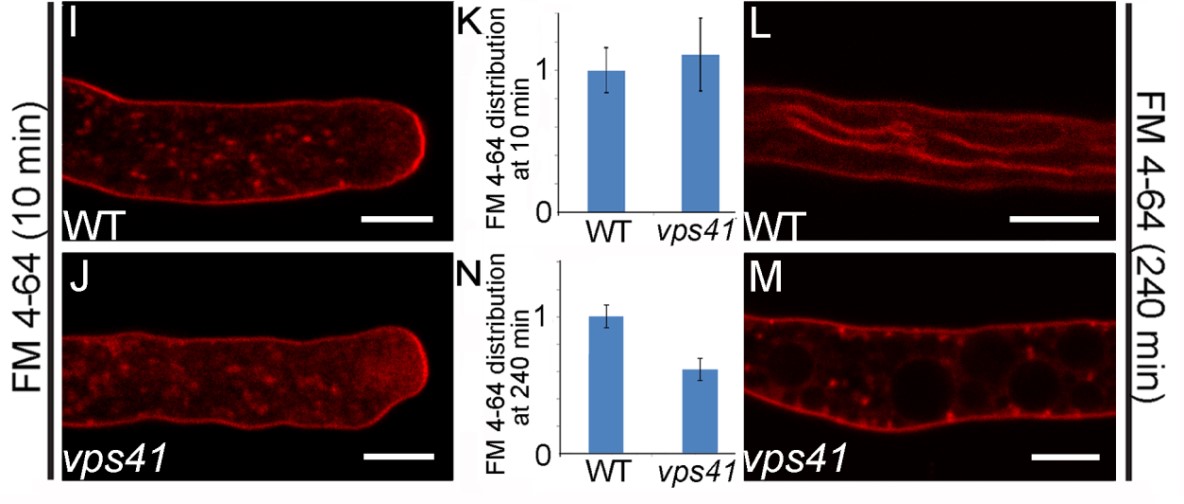PNAS:北京大学瞿礼嘉课题组揭示植物雌雄相互作用调控新机制
2016年5月16日,国际著名学术期刊《美国国家科学院院刊》杂志在线发表了北京大学生命科学学院瞿礼嘉教授课题组题为“AtVPS41-mediated endocytic pathway is essential for pollen tube-stigma interaction in Arabidopsis” 的研究论文,论文报道研究人员利用拟南芥发现植物雌-雄相互作用调控新机制。研究组博士生郝丽宏、刘敬婧副研究员(已故)和博士生钟声为论文共同第一作者,瞿礼嘉教授为论文通讯作者。
研究有花植物的有性生殖过程对于作物育种有着重要的作用。有花植物的受精过程起始于亲和性的花粉粒落在柱头,经过吸附和水化过程后萌发长出花粉管,随后花粉管生长穿过柱头并进入雌蕊的引导组织,最终被吸引进入胚囊,完成双受精。在这一过程需要雌雄双方之间大量的信号交流,而其中花粉管与柱头细胞之间的信号是如何进行交流的,到目前为止人们还知之甚少。
瞿礼嘉教授课题组采用反向遗传学的方法,发现VPS41在拟南芥花粉管与柱头细胞之间的信号交流过程中发挥了重要作用。VPS41是一个液泡分选蛋白,是细胞的内吞途径中的重要成员,参与了把胞外信号分子及其他物质从细胞膜上运进液泡或是其他亚细胞区间内进行降解这个生物学过程。在哺乳动物中,缺失VPS41蛋白会导致胚胎死亡,或者由于重要的信号分子无法进行适当的降解而导致严重的发育疾病。瞿礼嘉教授课题组的研究发现,如果VPS41蛋白功能缺失,拟南芥的花粉管在人工培养基上可以正常生长,但是在拟南芥的柱头上却不能穿入柱头生长,从而使植株的育性几乎降为零。他们进一步通过细胞生物学观察和生物化学实验发现,在vps41突变体花粉管中早期从膜上到晚期内吞体的内膜运输过程是正常的,但是几个标志性的蛋白质从晚期内吞体到液泡的内膜运输过程均受到了严重影响,暗示在拟南芥花粉管中VPS41参与控制从晚期内吞体到液泡的内膜运输过程。这项研究的结果表明,在拟南芥的柱头上很有可能存在某种信号分子负责雌-雄组织之间的识别,花粉管接受信号之后需要通过内吞途径把这种信号分子在液泡中降解;如果不能及时降解这个信号分子,其引发的信号途径就会出现混乱,从而影响花粉管的生长,使其无法穿入柱头。瞿礼嘉教授课题组的这项研究首次揭示了VPS41-介导的晚期内吞途径对于植物的有性生殖过程、特别是雌-雄相互作用具有非常重要的作用,也为未来最终鉴定出控制花粉管-柱头相互作用的信号分子奠定了基础。

图:缺失VPS41导致花粉管中的晚期内吞途径破坏
原文链接:
AtVPS41-mediated endocytic pathway is essential for pollen tube–stigma interaction in Arabidopsis
原文摘要:
In flowering plants, extensive male–female interactions are required for successful fertilization in which various signaling cascades are involved. Prevacuolar compartments (PVC) and vacuoles are two types of subcellular compartments that terminate signal transduction by sequestrating signaling molecules in yeast and mammalian cells; however, the manner in which they might be involved in male–female interactions in plants is unknown. In this study, we identified Arabidopsis thaliana vacuolar protein sorting 41 (AtVPS41), encoded by a single-copy gene with sequence similarity to yeast Vps41p, as a new factor controlling pollen tube–stigma interaction. Loss of AtVPS41 function disrupted penetration of pollen tubes into the transmitting tissue and thus led to failed male transmission. In the pollen tubes, AtVPS41 protein is associated with PVCs and the tonoplast. We demonstrate that AtVPS41 is required for the late stage of the endocytic pathway (i.e., endomembrane trafficking from PVCs to vacuoles) because internalization of cell-surface molecules was normal in the vps41-deficient pollen tubes, whereas PVC-to-vacuole trafficking was impaired. We further show that the CHCR domain is required for subcellular localization and biological functioning of AtVPS41. These results indicate that the AtVPS41-mediated late stage of the endocytic pathway is essential for pollen tube–stigma interaction in Arabidopsis.
作者:瞿礼嘉

